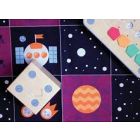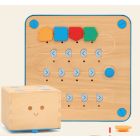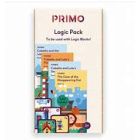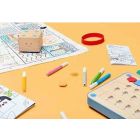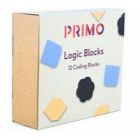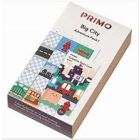Cubetto Product Review, From Helen Cotton at Amazing ICT
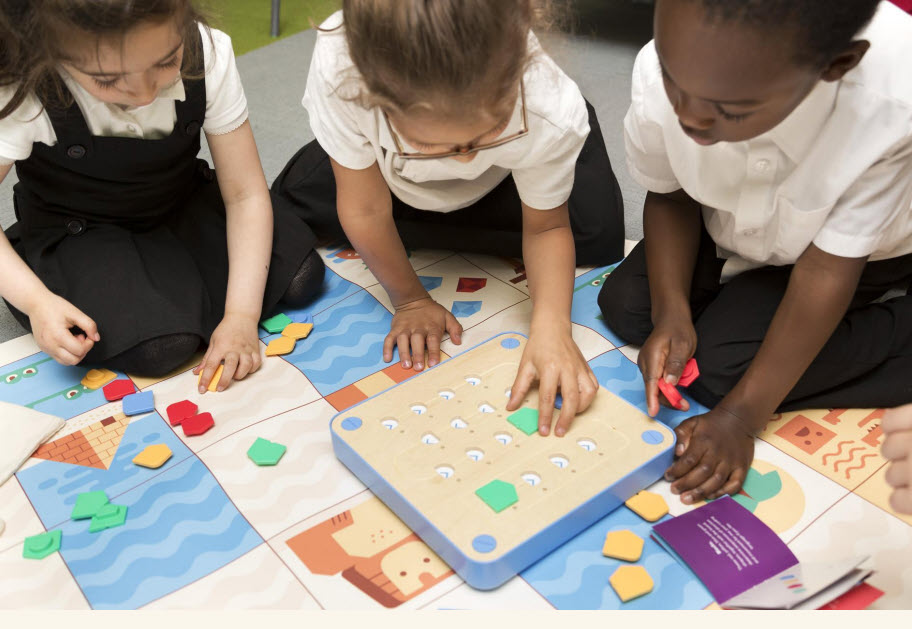
Powered by a tactile coding language, Cubetto is a friendly wooden robot that teaches children the key concepts of computational thinking like building algorithms, debugging, and even creating functions and loops - all without the use of screens or literacy.
Find out what Helen Cotton, Amazing ICT Associate and Primary Education consultant for the National Centre for Computing Education (NCCE) thought of Cubetto.
View Cubetto Range
What were your first impressions of the Cubetto Playset?
From the onset, Cubetto’s boxed presentation, the robust wooden equipment and sturdy, high quality material of the mat, all reflect the promise of durability that Cubetto gives. It fills you with confidence that Cubetto will stand the test of time and, more importantly, the EYFS and KS1 classrooms.
How does Cubetto work?
Cubetto has a programming board that children add their coloured tiles or blocks to. This can either be laid on a table-top, on the floor with the children or stood up, which makes it easier for a group of children to all be able to see clearly. The blocks slot into the holes easily and promotes awareness of shape and pattern as they only fit in one way. The bright, well-contrasted colours of the blocks identify the different jobs. They are easy to handle and manipulate, particularly useful for small fingers or for children struggling with fine motor skills. Cubetto robot itself also benefits from being large enough for children to handle without having any small parts that could break off, adding to its ease of use and making it a pleasure to work with.
How does Cubetto support cross-curricular teaching?
We used Cubetto with a small group of children and I would recommend it for further adult-led activities for teaching the fundamentals of programming. There is huge potential for cross-curricular teaching as well as children were focussed; they listened well and practised taking turns.
We found that Cubetto benefits the children’s learning in many ways. It lends itself well to story-writing and getting the children using their imaginations. Very quickly, children were offering ideas and building a character for Cubetto. This led to children writing their stories in the writing area for continuous provision and acting out journeys whilst playing outside. The conversations around distance, measure, directional vocabulary, and the constant evaluating of what Cubetto could and couldn’t do were rich and supported our maths and outdoor provision in many ways. For example, a couple of friends decided to find out how many times Cubetto would have to move forward to get from the tree to the fence.
How does Cubetto support computing activities?
Throughout their computing activities, the children developed skills such as giving and receiving instructions, working together, spotting patterns and perseverance whilst they debugged any problems that arose. The scope for practising the concepts and approaches of computational thinking are far-reaching, making Cubetto particularly effective when focussing on characteristics of effective learning in the Early Years. Moving into Key Stage 1, teachers can still utilise Cubetto when teaching computing, and continue to engage the children whilst exploring algorithms and algorithmic thinking. The function block and the negation block were used with Reception children, but the Year 1 children managed and used these blocks well. It meant that progression was clear. Cubetto is excellent value for money when used across multiple settings or year groups.
How does Cubetto compare to other Coding tools?
In comparison to other floor robots, Cubetto has the advantage of showing the instructions or algorithm clearly. When the children’s instructions for a floor robot are not visible, it can be frustrating if (and when) the robot does not do what is predicted or expected. There is often no way to look back and fix the error. However, Cubetto’s blocks are visible to the pupils. When the program runs, there is a helpful light next to each block that flashes at the point the program is up to – especially useful when following the code. I asked the children to point to each block as they followed the program to further embed their understanding of cause and effect, with the block being the cause and the action being the effect. (see video attached as an example).
Furthermore, Cubetto is quiet and does not need a large space to use it. Some programmable equipment or toys are a lot brighter and more musical but are also loud and can require substantial amounts of space which many settings do not have the luxury of. Therefore, Cubetto fits the needs of an EYFS setting or a KS1 classroom, well.
Why is it important for children to learn coding at a young age?
The new statutory framework for the Early Years Foundation Stage, refers to the characteristics of effective teaching and learning as:
Playing and exploring - children investigate and experience things, and ‘have a go’
Active learning - children concentrate and keep on trying if they encounter difficulties, and enjoy achievements
Creating and thinking critically - children have and develop their own ideas, make links between ideas, and develop strategies for doing things.
(https://assets.publishing.service.gov.uk/government/uploads/system/uploads/attachment_data/file/974907/EYFS_framework_-_March_2021.pdf)
Coding is at the heart of these characteristics as children tinker and work out what the robot can and cannot do. Whilst coding, mistakes are bountiful; yet this is celebrated as an opportunity to fix the error (debug) and solve the problem by finding patterns or similarities and differences in their strategies. Often, coding and programming activities are engaging and fun whilst stimulating thinking skills that engender collaboration and perseverance. By offering opportunities to code, children can build upon all seven areas of learning and development, and teachers will find clear links between the characteristics of effective learning and computational thinking.
Would you recommend Cubetto?
I would recommend Cubetto for Early Years and Key Stage 1 because it is so clear and easy to understand. The sparks of imagination from the children when introduced to Cubetto were wonderful and led to many child-led activities such as hats being made to fit Cubetto robot and stories being written about the travels of Cubetto.
Overall, what do you think of the product? Does it do what it sets out to do?
Cubetto is well made, robust and perfect for younger children to handle. The lesson plans, the book and the highly visual aspects of the blocks and the programming board mean that Cubetto is a great piece of kit for a school to teach programming, computational thinking and much more.

Helen Cotton
Amazing ICT Associate and Primary Education consultant for the National Centre for Computing Education (NCCE)
Subscribe to our Mailing List
For news, product updates, offers and more, signup to our newsletter. See our Privacy Policy here


